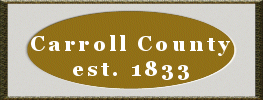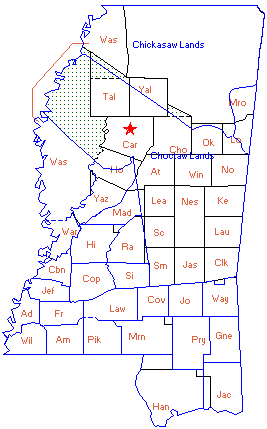Formation
Carroll County was established by legislative act in 1833, and
was the twenty-seventh county to organize. When organized, Hiram
Runnels was Governor of Mississippi and Andrew Jackson was President
of the United States. Carroll County was carved out of a part of the
territory ceded by the Choctaw Indians to the United States by the
Treaty of Dancing Rabbit Creek in 1830. As originally established,
it embraced territory more than twice its present size. It extended
on the north three miles farther than now, end reached some five
miles east of the present city of Winona (now in Montgomery County).
On the west it was bounded by the Tallahatchie and Yazoo rivers. The
southern boundary was as at present, but then extended from the
Yazoo to Big Black River. It was named for Charles G.
Carroll, of Maryland, one of the immortal signers of
the Declaration of Independence, who said, after giving his
signature, "If this be treason, I want it known which Carroll it is.
I am Charles G. Carroll, of Carrollton, Maryland."
While some white settlers were already in the territory, there
was a great influx of people from a number of states on the East as
soon as the county was created. These came from leading families of
Virginia, the Carolinas, Georgia, Tennessee, and other states.
Early History
Carrollton was selected in 1834 as the location for the seat of
county government and soon grew into a thriving town. Middleton,
Shongalo, and Black Hawk rapidly became towns of prestige and
influence, Shongalo later became Vaiden and the county seat of the
Second District.
On March 11, 1834, the commissioners who had been designated to
organize the county held their first meeting. This Board of Police
was composed of Edmunds G. Whitehead,
Daniel McEachern, Thomas
Matthew, Woodward Applewhite
and John Rogers. Of these, Whitehead was
chosen president. The clerk of the probate court, Thomas
Rhodes, was by law, clerk of the Board of Police, and
Abraham G. Herring was sheriff. The other
officers of the county were William G. Herring,
circuit clerk and William Blanks, probate
judge.
This meeting of the Board of Police was held in the home of
George W. Green, which, as the minutes
show, was near the center of the county and not far from the present
town of Carrollton.
The first duty of the Board of Police was to approve the bonds of
the county officers, and then followed the division of the county
into beats, which was, in effect about the same as now.
Elections were ordered to be held in the different beats for
justices of the peace and constables, and at the same time and
places an election was ordered to be held for a county treasurer.
This election was held at the houses of different citizens, there
not being any public places for meeting. In Beat 1, at the house of
James Parker; in Beat 2, at the house of
Thomas G. Nixon; in Beat 3, at the home of
Duncan C. McLoed; in Beat 4, at the house
of George W. Green; and in Beat 5, at the
house of John McCaskell.
At a special term of the Board of Police in April,
Edward G. Howard qualified as county surveyor,
Daniel S. McDougal as coroner, Jacob
Miller as ranger, and John Oldham
as tax assessor and collector.
In November, 1834, the FIRST TERM OF THE CIRCUIT COURT of Carroll
County was held in the house of William N. Miller
in Carrollton, and was presided over by James Scott,
judge of the Second Judicial District. The district attorney,
Thomas J. Coffin, was absent, and
Robert Hughes, an attorney-at-law of Carrollton,
was appointed by the court for the term. All lawyers had to be
registered and sworn as attorneys and counselors at law, and the
following were enrolled and sworn: Robert Hughes,
Joseph Drake, J. M. Maury,
John Taylor, A. H. Baxton,
W. G. Kendall, James Enloe,
and David 0. Shattuck. The first grand
jury was composed of the following men: Andrew B. Oldham,
Leroy R. Brewer, James
Standley, James Cobb,
William Kirkwood, William
Alford, Samuel Bell,
William M. Thompson, William Baxter,
Edmond O'Neal, and Henry
Moffit. Samuel Bell was
appointed foreman. Their first important case was a murder involving
a Negro slave named Anderson, for which he
was convicted and hanged.
The second term of Circuit Court was held in May, 1835, and was
presided over by Judge Robert Hughes as
judge. The following new lawyers were present and were sworn in:
A. R. Herron, Edward H. Durell,
H. S. Eustis, Jeremiah Cooper,
Robert J. Green, and Andrew
Neill. The district attorney was again absent, so
Joseph Drake served in that capacity.
At the April, 1836 term of the Circuit Court, David
0. Shattuck served as district attorney and
James Wellons took the oath as attorney at law.
This was the first term at which James Collins
served as circuit clerk.
In October, 1837, G. F. Neill,
William Cothran, William Clark,
and Vincent D. Butler came into court and
were sworn as attorneys at law.
In 1834, the first deed for land was from John
Neville to Collins and
Hooker. The first marriage license on
record in the chancery clerk's office was issued to
Robert Kelly and Delia Oldham
on May 25, 1834, who were married by William Blanks,
probate judge.
In the 1870s, considerable of this vast territory was taken from
Carroll to compose parts of the counties of Grenada, Leflore, and
Montgomery, while that portion of the present county east of Big
Black River was given to Carroll from Choctaw County. This still
left a county of 624 square miles.
Two of her former citizens were leading United States Senators:
James Z. George, and Hernando
DeSoto Money.
Bibliography
History of Carroll County; W. F. Hamilton and Bingham
Duncan
A History of Carroll County; Charles A. Neal


